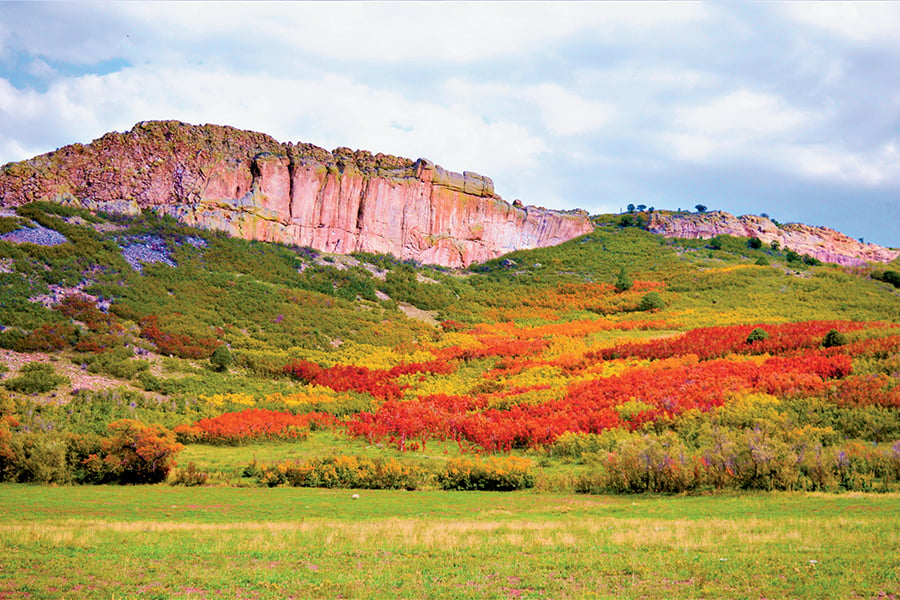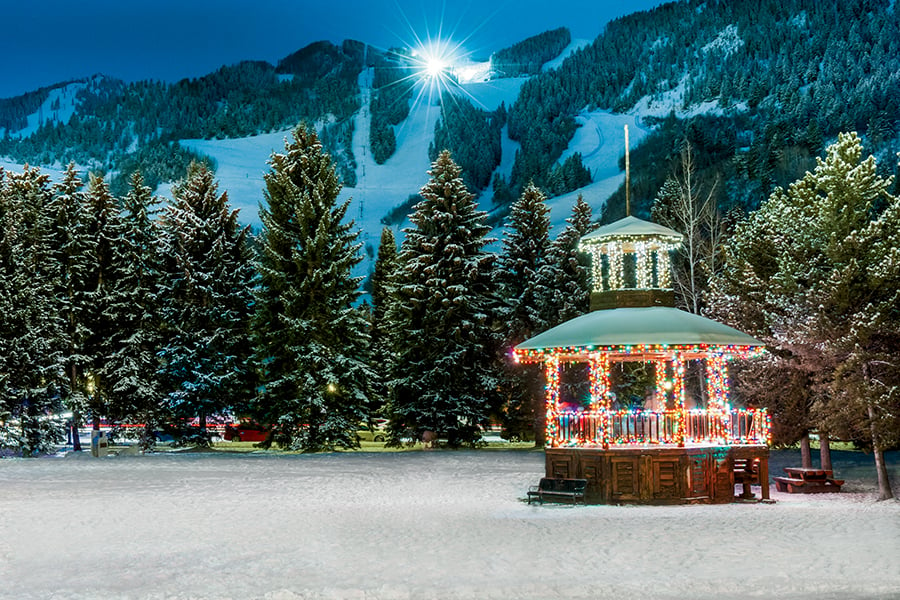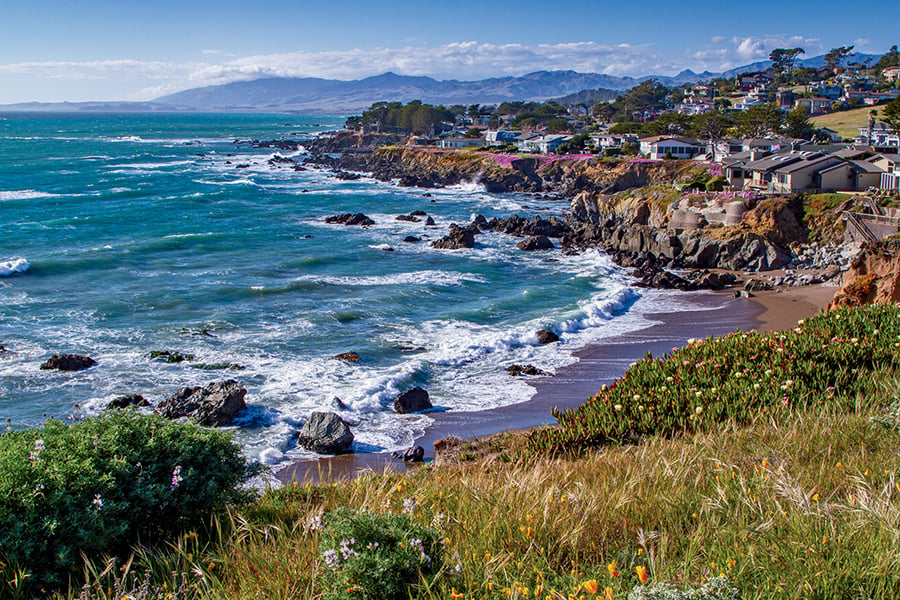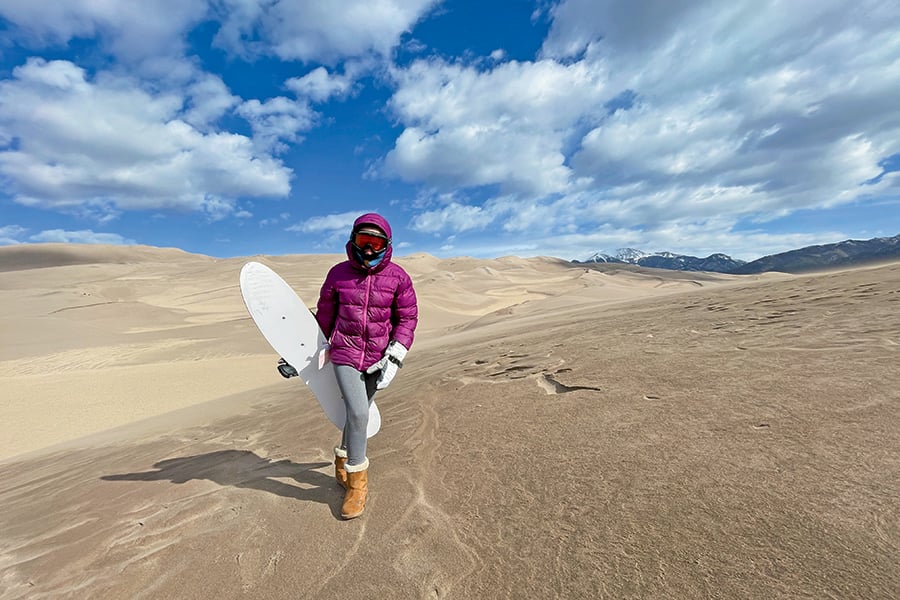GOLD RUSH 2021: Colorado’s Other Fall Colors

If autumn in Colorado is painted aspen gold, why was I seeing red? Not just red, but orange and purple, too. Did I make a wrong turn at Walsenburg and end up in New England? No, these weren’t sugar maple, ash, or beech trees. Actually, they didn’t look like trees at all, more like clumps of gnarly bushes. The source of all this unexpected color was the Gambel oak, though most people most people don’t bother with its real name. “Scrub oak” seems to fit for an unassuming shrub that no one will ever confuse with the golden glamor models of Colorado high country.
Taking a gamble

Cherry Creek spills over a rock ledge in Castlewood Canyon State Park, one of the Gambel oak fall foliage “hotspots,” along Colorado Hwy 83 between Franktown and Monument. © Pat Woodard
I was at this spot along the Highway of Legends Scenic Byway, south of La Veta, as a gamble on Gambel oak. Could I put together a Colorado fall colors road trip, replacing the lovely aspen with the lowly scrub oak, and have it pay off in something more than rust-colored drabness? You bet I could!
While Gambel oak is widespread across Colorado’s foothills and lower mountain elevations, its autumn displays are hit or miss. I plotted a course that would take me south from metro Denver along Colorado Highway 83, hitting scrub oak hotspots at Castlewood Canyon State Park near Franktown, and Lincoln Mountain Open Space Park near Monument. Elevation is an important factor in any foliage quest, so I added a leg on the Highway of Legends that would include a climb of a couple thousand feet, giving me a better chance to catch some scrub oak stands in a climate sweet spot of peak color—not that I needed a special reason to drive this spectacular route. Designated as a National Scenic Byway just this year, the Highway of Legends meanders from La Veta to Trinidad, passing unusual volcanic formations, historic ruins, and small-town Victorian architecture.
Starting my tour
The first stops on my Respect for the Scrub Oak Tour were rewarding, for different reasons. At Castlewood Canyon, the oaks were still a little shy of peak color, but bright crimson exploded from a vine that wound around and through the twisted trunks. The Virginia creeper’s vibrant red leaves dramatically offset clusters of blue berries. Things were a bit further along at Lincoln Mountain. Stands of scrub oak decked out in orange, ochre, and mustard surrounded solitary pines along a short and easy trail leading to overlooks on rocky bluffs.
Tramping around colorful fall landscapes can lull you into believing there is no such thing as the tyranny of time. That’s usually when it slaps you in the face. By the time I got back to the car, I knew I wouldn’t make it to the Highway of Legends until well after dark. Checking my road atlas, I figured I could make Colorado City, between Pueblo and Walsenburg, by dusk. It was just off I-25, so there were motels with vacancies, even a restaurant a friend had recommended, and it would bring an easy 35-mile drive in the morning to the La Veta starting point for the 70-mile semi-circular drive to Trinidad on Colorado Highway 12, The Highway of Legends.
My friend was right. The Three Sisters Tavern and Grill hit the spot. I’m not sure I’d ever seen such peaceful coexistence on one menu; the pork and avocado burrito residing right next to the fish and chips, somehow fitting harmoniously alongside both the Rueben and the apple chicken wrap. I knew whatever I got would have a Sisters’ carrot cake chaser.
Enjoying the payoff

Delicious pastries fill the shelves at Ryus Baker in La Veta. © Joshua Berman
The next morning saw me walking out of the Ryus Avenue Bakery in La Veta (open Tuesdays, Thursdays, and Saturdays from 8 a.m. to 2 p.m.) with an espresso in one hand and a bear claw in the other. Between the caffeine and the sugar, I was fully fueled for my adventure. This part of the state is dominated by the Spanish Peaks, two mountains that stand next to each other in splendid isolation from other ranges. Unlike many Colorado mountains, these are volcanic in origin. Radiating outward from the peaks like spokes from a wheel, tall stone walls extend for miles. These are geological formations called dikes, the solidified remnants of magma that rose from cracks in the earth. The scrub oak forests at the base of the dikes were at a higher elevation than those I’d seen farther north, and the difference was startling. Bright belts of red shot across the hillside, mixed with bands of maroon, orange, and the green of leaves yet to change. My Gambel gamble was paying off, and this was just the start of my Highway of Legends journey.
As the highway climbed south, the scrub oak thinned out and then disappeared as the now defunct Cuchara Valley Ski Area came into view. The village of Cuchara is still very much alive with quaint shops and cafés. The former ski area now draws visitors as a public park.

Historic coke ovens along the Highway of Legends Scenic Byway in Cokedale. © Dreamtime.com/Timrobertsaerial
From 10,000-foot summit of Cucharas Pass, the peaks of the Culebra Range seemed almost close enough to touch. Colorado’s southernmost 14,000-foot mountain rises here. Culebra Peak also has the distinction of being the state’s only privately owned 14er. For $150, you can hike to the summit. If you’re short of time and money, skip that for a stop in Cokedale. It doesn’t cost anything to see what’s left of the coal boom that gave the town its name. In the early 1900s, long, curving rows of stone ovens cured, or “coked,” impurities out of locally mined coal. The 300 ovens remaining today evoke the ruins of an ancient city.
Ironically, the closing of the coal mines may have helped save many of the wonderful historic buildings in nearby Trinidad, as hard times stalled the sort of make overs that come with prosperity. The Trinidad History Museum isn’t a building as much as it is a downtown block featuring a Victorian mansion, an adobe house, and a museum devoted to the Santa Fe Trail—a worthy “last stop” on the Highway of Legends.
Heading back north toward Denver, I thought about staying on I-25 to save time. Then I remembered how chilly it had gotten the night before. Looking for an exit, I thought, you know, some of those scrub oak along the side roads might be peaking right about now. And sure enough, they were.




